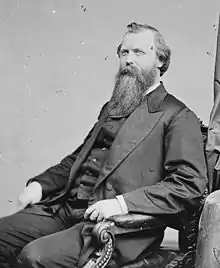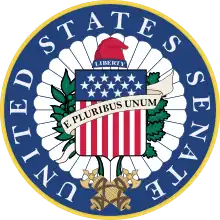William M. Stewart
William Morris Stewart (August 9, 1827 – April 23, 1909) was an American lawyer and politician. In 1964, he was inducted into the Hall of Great Westerners of the National Cowboy & Western Heritage Museum.[1]
William M. Stewart | |
|---|---|
 | |
| United States Senator from Nevada | |
| In office February 1, 1865 – March 3, 1875 | |
| Succeeded by | William Sharon |
| In office March 4, 1887 – March 3, 1905 | |
| Preceded by | James G. Fair |
| Succeeded by | George S. Nixon |
| 5th California Attorney General | |
| In office 1854–1854 | |
| Preceded by | John R. McConnell |
| Succeeded by | William T. Wallace |
| Personal details | |
| Born | August 9, 1827 Galen, New York, US |
| Died | April 23, 1909 (aged 81) Washington, D.C., US |
| Political party | Republican, Silver (1893-1901) |
| Profession | Attorney |
| Signature | |
Personal
Stewart was born in Wayne County, New York, on August 9, 1825. As a child he moved with his parents to Trumbull County, Ohio. As a young man he was a mathematics teacher in Ohio. In 1849 he began attending Yale University but left in 1850 to move to California. He came to California because of the Gold Rush. He arrived in San Francisco, California, and soon left to begin mining near Nevada City, California.[2]: 1–4
In 1903 he was reputed to be one of the richest men in the Senate (with a fortune of some $25 million and ownership of silver mines) and the oldest member of that body.[3]
Marriages
Stewart was married to Annie Elizabeth Foote, daughter of his law partner, Henry S. Foote, on May 31, 1855.[2]: 8
His second wife was May Agnes Cone, widow of Theodore C. Cone. They were wed on October 26, 1903, in the Piedmont Hotel, Atlanta, Georgia. Judge Thomas M. Norwood, who had served with Stewart in the U.S. Senate was the best man.[3]
According to the book Reminiscences of William M. Stewart (1908) in May 1905 he moved with his new wife and her daughter to the Bullfrog Mining District (Nevada), where he started a law firm and law library.
Political career
California
.pdf.jpg.webp)
In 1851 Stewart ran for sheriff of Nevada County, California, and the next year, in February, he was at the Whig State Convention in Sacramento, where he was named a delegate to the party's national convention.[2]: 5
In 1852 he studied law in the office of Nevada County District Attorney John R. McConnell, becoming a Democrat in the process. He was appointed to succeed McConnell as district attorney in November 1852. At that time he became a "motivating force" in beginning a Democratic newspaper, Young America (later called The Nevada Democrat.) Stewart continued as district attorney after an election in November 1853.[2]: 6, 7
He was acting attorney general of California from June 7, 1853, until December.[2]: 8
Stewart moved to San Francisco and became a law partner with Henry S. Foote, Louis Aldrick, and Benjamin Watkins Lee.[2]: 8
State
In 1860 Stewart moved to Virginia City, Nevada, where he participated in mining litigation and helped the development of the Comstock Lode. As Nevada was becoming a state in 1864, he helped the state develop its constitution. Stewart's role as a lawyer and politician in Nevada has always been controversial. He was the territory's leading lawyer in mining litigation, but his opponents accused him of bribing judges and juries.[4] Stewart accused the three Nevada territorial judges of being corrupt, and he barely escaped disbarment.[5]
United States Senate
In 1864, Stewart was named by the Nevada State Legislature to the United States Senate as a Republican. He served in the Senate from 1865 until 1875 when he retired and practiced law again in Nevada and California.[6] In 1873, Stewart's palatial residence, nicknamed Stewart's Castle, was built in Washington, D.C., and became a center of the city's social scene.[7][8] He was elected to the Senate again in 1887 and reelected in 1893 and 1899. During the 1890s he left the Republican Party to join the Silver Party, which supported the Free Silver movement.[6] During this time, he caucused with the Silver Republicans.
During his many years in the Senate, Stewart drafted or co-authored important legislation, including several mining acts and laws urging land reclamation by irrigation. Most famously, Stewart is given credit for authoring in 1868 the Fifteenth Amendment to the United States Constitution protecting voting rights regardless of race, color, or previous condition of servitude. During his time as senator, Stewart received 50,000 acres of land for his service on the Committee on Pacific Railroads.[9] In 1871, President Ulysses S. Grant offered Stewart a seat on the United States Supreme Court. Stewart declined. Stewart was also involved in an international scandal where he promoted the sale of a worthless worked out Emma Silver Mine at Alta, Utah for millions of pounds to unsuspecting English citizens.[10]
In 1899, Republican journalist and diplomat William Eleroy Curtis detailed Stewart's reputation amongst his colleagues:
“There was an air of gloom about the Senate all to-day, as if some calamity were impending or some great sorrow had fallen upon the members. It was the result of the news from Nevada — the re-election of Senator Stewart and the prospect of being compelled to listen to his speeches for another Six years. Mr. Stewart is an interminable talker, but his colleagues could endure that if he would talk on more than one subject, which he declines to do. He makes the same speech over and over again almost every day, so that Senators with good memories can repeat it almost verbatim, and his familiar phrases about the capitalistic vampires with the fetid fangs and the money devils and the crime of 1873 are more familiar to a majority of the Senate than the Ten Commandments…"
"Ex-Senator Evarts hit off Mr. Stewart’s peculiarities in a little story that he told at a dinner given in honor of Senator Spooner, when the latter was leaving public life six years ago… Senator Evarts, who next took to the floor, said that Stewart reminded him of a man he had met at an insane asylum one time when he was acting as a member of a board of visitors. The Superintendent told them that they must say cheerful things to the patients, and therefore when he saw a lunatic sitting astride of a table beating it with a whip and pretending to drive it with a pair of string lines, he walked up to him and said: 'That’s a fine hobby you have there, my friend.' 'It isn’t a hobby,' answered the lunatic. 'It’s a horse.' 'What’s the difference between a horse and a hobby?', suggested Mr. Evarts. The lunatic turned on him with an air of supreme contempt and remarked: 'You blank fool, anybody can get off a horse, but nobody ever got off a hobby.'"[11]
In 1902, he was in The Hague in connection with the Mexican-American arbitration case, when his wife, the daughter of Confederate Senator Henry S. Foote,[12] was killed in a motor-car accident in Alameda, California.[13]
Post-political career
.jpg.webp)
Stewart retired from the Senate in 1905. He was a co-founder of the city of Chevy Chase, Maryland, along with Francis G. Newlands, a fellow Senator from Nevada.[14] Stewart remained in Washington, D.C., and died there four years later. He was cremated and the ashes were originally kept in Laurel Hill Cemetery in San Francisco before being moved to Cypress Lawn Memorial Park in Colma, California.
In popular culture
The actor Howard Negley (1898–1983) played Stewart in the 1953 episode, "The Bandits of Panamint", of the syndicated television anthology series, Death Valley Days, hosted by Stanley Andrews. In the story line, Stewart enters into an agreement to gain pardons for two bandits, played Rick Vallin and Glase Lohman, who accidentally stumble upon a rich silver strike. Stewart, however gains ownership of the mine. Sheila Ryan and Gloria Winters played young women with romantic interests in the outlaws.[15]
In another 1953 episode of Death Valley Days, "Whirlwind Courtship", Michael Hathaway, who appeared only twice on television, played Stewart as a young Nevada lawyer determined to wed Annie Foote, a daughter of former U.S. Senator Henry S. Foote of Mississippi, who had relocated to the West.[16]
In a 1954 episode of Death Valley Days, entitled "The Light on the Mountain," the role of Stewart was played by Michael Colgan (1921–2006). In the story line, Stewart and Richard Corey (Glase Lohman) attempt to clean up the justice system in Nevada in preparation for statehood in 1864. Phyllis Coates played Stewart's wife, Annie. Angie Dickinson was cast as Sabina Harris, a young woman with an interest in Corey.[17]
References
- "Hall of Great Westerners". National Cowboy & Western Heritage Museum. Retrieved November 22, 2019.
- Servant of Power, University of Nevada Press, Reno, 1983
- "Senator Stewart, Patriarch of the United States Senate, Leads to Altar Mrs. May Agnes Cone, of Madison, Ga.," Atlanta Constitution, October 27, 1903, page 1
- Grant H. Smith, 1943, The History of the Comstock Lode, Univ. of Nevada Bulletin, v.37, n.3, p.69.
- Dan Plazak, 2006, A Hole in the Ground with a Liar at the Top, Salt Lake City: Univ. of Utah Press, ISBN 0-87480-840-5, p.26-27.
- "Senators Who Changed Parties During Senate Service (Since 1890)". United States Senate. Retrieved February 6, 2017.
- Hansen, Stephen A. (2014). A History of Dupont Circle: Center of High Society in the Capital. Charleston, South Carolina: Arcadia Publishing. pp. 31–44. ISBN 9781625850843.
- Goode, James M. (2003). Capital Losses: A Cultural History of Washington's Destroyed Buildings (Second ed.). Washington, D.C.: Smithsonian Institution Press. pp. 96–97. ISBN 1-58834-105-4.
- Faragher, John Mack (2006). Out of Many: A History of the American People, 5th Edition. Upper Saddle River, NJ: Pearson Prentice Hall. p. 505.
- E.G.D. (October 9, 1893). "New York Times" (PDF).
- Curtis, William Eleroy (February 5, 1899). "Senator Stewart's Return". The New York Times. Retrieved August 17, 2023.
- Carter, John D. (May 1943). "Henry Stuart Foote in California Politics, 1854-1857". The Journal of Southern History. 9 (2): 224–237. doi:10.2307/2191800. JSTOR 2191800.
- "Latest intelligence - Fatal motor-car accident". The Times. No. 36873. London. September 15, 1902. p. 3.
- "Chevy Chase Historical Society". Archived from the original on March 3, 2008.
- "The Bandits of Panamint on Death Valley Days". Internet Movie Database. Retrieved February 12, 2019.
- "Whirlwind Courtship on Death Valley Days". Internet Movie Database. Retrieved February 14, 2019.
- "The Light on the Mountain on Death Valley Days". Internet Movie Database. Retrieved February 12, 2019.
- United States Congress. "William M. Stewart (id: S000922)". Biographical Directory of the United States Congress.
External links
- William M. Stewart, The Online Books Page, University of Pennsylvania
 Media related to William M. Stewart at Wikimedia Commons
Media related to William M. Stewart at Wikimedia Commons

